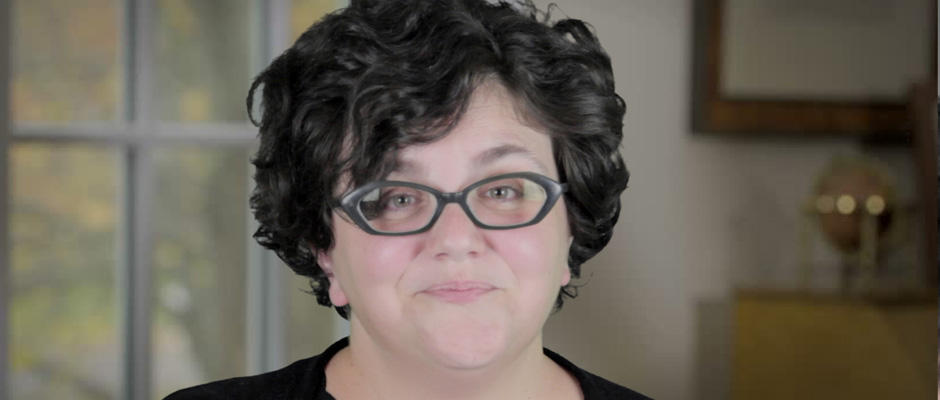This story originally appeared in Columbia Magazine
A woman who complains to her doctor about extreme menstrual pain is likely to be told, It’s a normal part of being a woman, so tough it out.
And yet, too often, the pain is not normal: it’s the result of a disease called endometriosis, which occurs when uterine cells migrate outside the uterus, forming lesions that glom onto other organs. Experts say that this condition, which can damage the reproductive system if left untreated, often goes undiagnosed, because its primary symptom is an intense pelvic pain that occurs around the same time as a woman’s period. According to many women’s health advocates, the tendency of physicians to dismiss this pain as ordinary menstrual cramps has perpetuated a cycle of misinformation about endometriosis, with the medical establishment viewing it as an uncommon disorder and therefore investing little money in its research.
Three years ago, Noémie Elhadad ’06SEAS, a Columbia medical researcher who suffers from endometriosis, decided to take matters into her own hands. A computer scientist who specializes in wresting insights from messy data sets, like collections of doctors’ notes or patients’ comments in online forums, she figured that if no major funding was available for a study on endometriosis, she’d come up with a technological hack to conduct one on the cheap. And one night while participating in a patient support group with fellow “endo” patients, as women with the disease call themselves, she had an idea for how to do it.
“I noticed that a lot of women were using smartphone apps that track your menstrual cycle, based on information you enter about any cramping, bloating, or bleeding you experience each day,” says Elhadad. “And I thought, why don’t we design a similar tool for women with endometriosis? Then they can document the nuances of their condition as citizen scientists.”
Elhadad realized her vision last year, launching a crowdsourcing project called Citizen Endo. At the heart of the effort is a smartphone app, Phendo, that Elhadad developed with a $50,000 grant from the Endometriosis Foundation of America. The project has already amassed the largest collection of clinical data about endometriosis in existence. Nearly three thousand endometriosis patients in sixty-five countries have used the app on a daily basis, some for several months at a stretch, to document their pain, energy levels, moods, diet, physical activities, medications, and pain-management strategies. The data is then transmitted to a computer in Elhadad’s office at CUIMC, where she and the members of her research team analyze it for insights into how the disease manifests in different women.
RELATED: A Q&A With Noemie Elhadad About Her New Endometriosis Symptom-Tracking App, Phendo
“A lot of the women choose to participate simply because they’re passionate about helping to push the science forward,” says Elhadad.
The goal of the project, Elhadad says, is to describe the full range of endometriosis’s symptoms, and thereby help physicians diagnose and treat more cases. (The disease is typically treated with laparoscopic surgery to remove the lesions and hormonal therapy to prevent their regrowth.)
“Today, a doctor who’s trying to diagnose endometriosis doesn’t have a lot of information to go on,” says Elhadad, noting that previous studies on the disease have been too small to provide a proper accounting of its symptoms. “And plenty of the information that is available, we’re finding out now, is just plain wrong.”
Consider, for example, what the current medical literature says about the pain endured by endometriosis patients. A seminal paper on the topic, published by Harvard scientists in 2002, suggests that the pain is restricted to the pelvic region. But that’s not true, according to Elhadad. She says that her data indicates that more than half of all women with the disease have pain that radiates down their back, arms, or legs — sometimes in combination with pelvic pain and sometimes without it. And while the Harvard paper states that endometriosis pain always strikes women in sync with their periods, Elhadad’s data reveals that many endometriosis patients suffer chronic pain that can persist for months or even years.
“It’s actually been common knowledge for quite some time now among women with the disease, and some savvy gynecologists, that the pain can persist outside of a woman’s period,” she says. “But ours is the first study to document it.”
Other findings were completely unexpected. After asking to see their subjects’ medical histories, for example, Elhadad and her colleagues, who include biomedical informatics PhD candidate Mollie McKillop ’14PH, discovered that many of the women had a history of urinary problems, such as incontinence or painful urination, not previously linked to endometriosis. The researchers are now scouring the data they received via the smartphone app to determine, for example, if a history of urinary issues may be linked to the severity of the disease, responsiveness to certain pain-management strategies, or a woman’s chances of suffering what is perhaps the most feared outcome of the disease: infertility.
“We know already that about half of all women with endometriosis lose their ability to have children, often at a very young age, but we can’t predict who this will happen to,” Elhadad says. “I’ve heard twenty-two-year-old women say things like, ‘Well, I don’t really want to have a child right now, but maybe I should start trying before it’s too late.’ That’s a horrible situation to be in. But if we can identify those patients who are likely to become infertile, we could share that information and help them make better choices.”
The Columbia researchers say they’re still at the beginning of their evidence-gathering journey. Later this year, they will enroll an additional seven thousand women in Citizen Endo. They are also planning to expand the scope of their project to eventually incorporate analyses of their subjects’ hormonal profiles, which they would acquire by having women submit blood or saliva samples. There’s no end to the discoveries this effort could yield, the researchers say, since scientists currently know so little about endometriosis. Among the questions they hope to investigate are what causes the disease; whether it might be treated without surgery; and how prevalent it is (some gynecologists have estimated that 6 to 10 percent of all women may have endometriosis, although they say this assessment is very speculative).
“Just about anything we learn is going to be valuable, because we’re starting from a place of such ignorance,” says Elhadad, noting that women with the disease currently go an average of seven years before being diagnosed.
Elhadad suspects that women are enthusiastic about participating in Citizen Endo because they’re grateful that medical professionals are now listening to them. And she says that she hopes to make their efforts more rewarding by eventually adding new features to her smartphone app to give women individualized tips on how best to manage their condition.
“One of the wonderful things about mobile technology today is that medical researchers and study subjects can communicate back and forth in ways that benefit everybody,” she says. “I mean, sure, I now have access to huge amounts of information about these women’s daily lives. But I need to give them back something in return. And what I’m going to give them should be the most personalized, intimate, and timely health advice they’ve ever received about their condition.”










